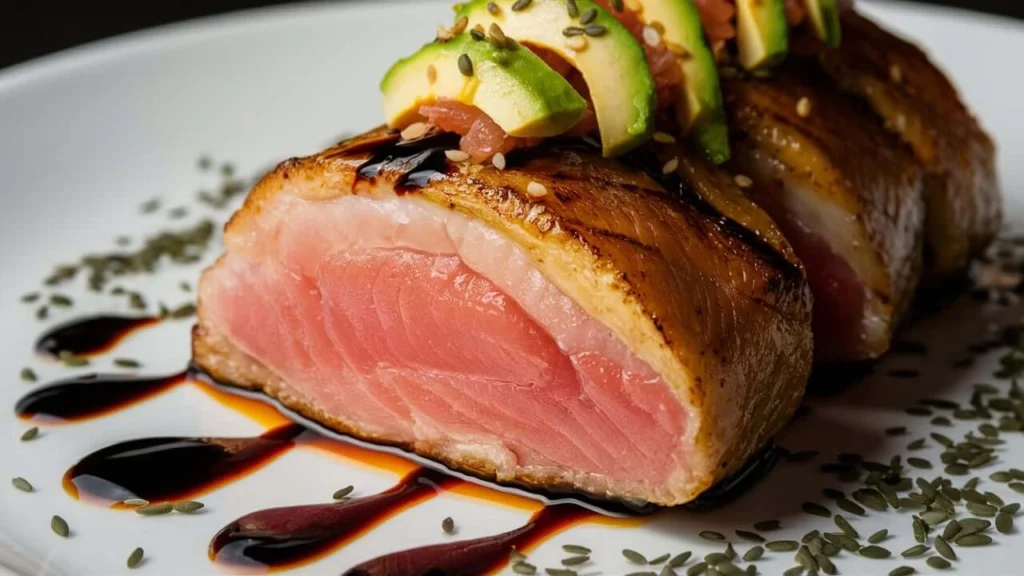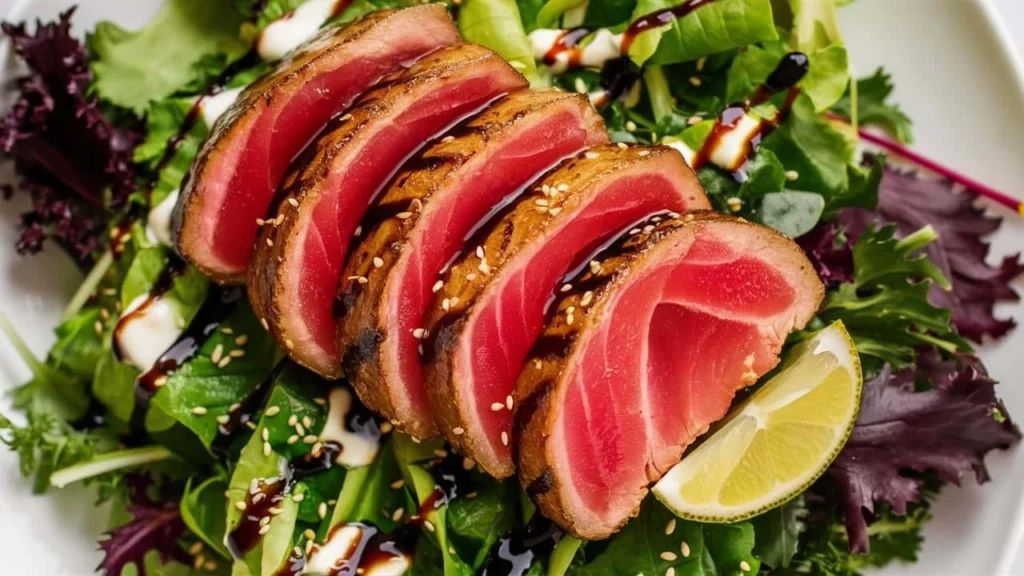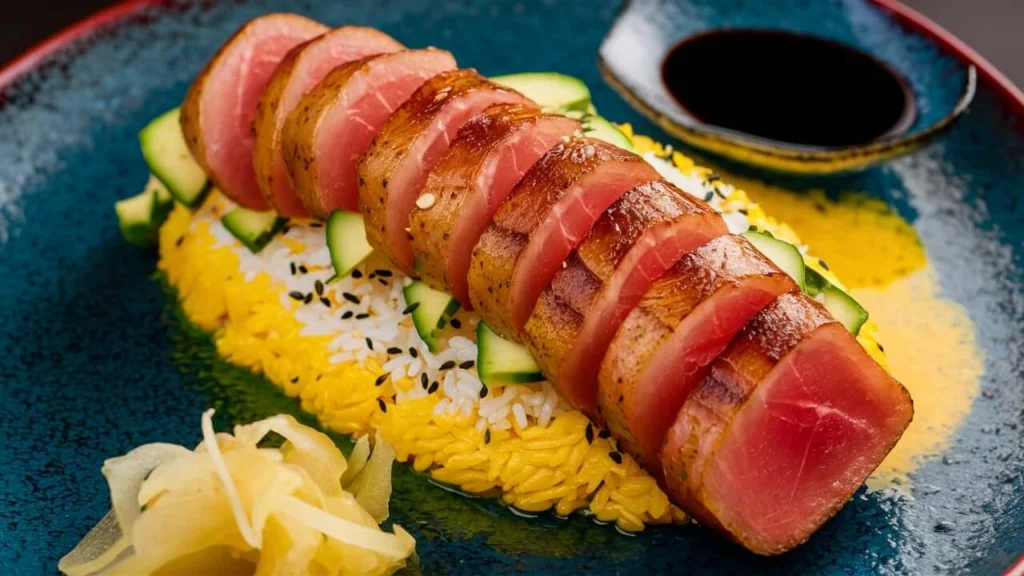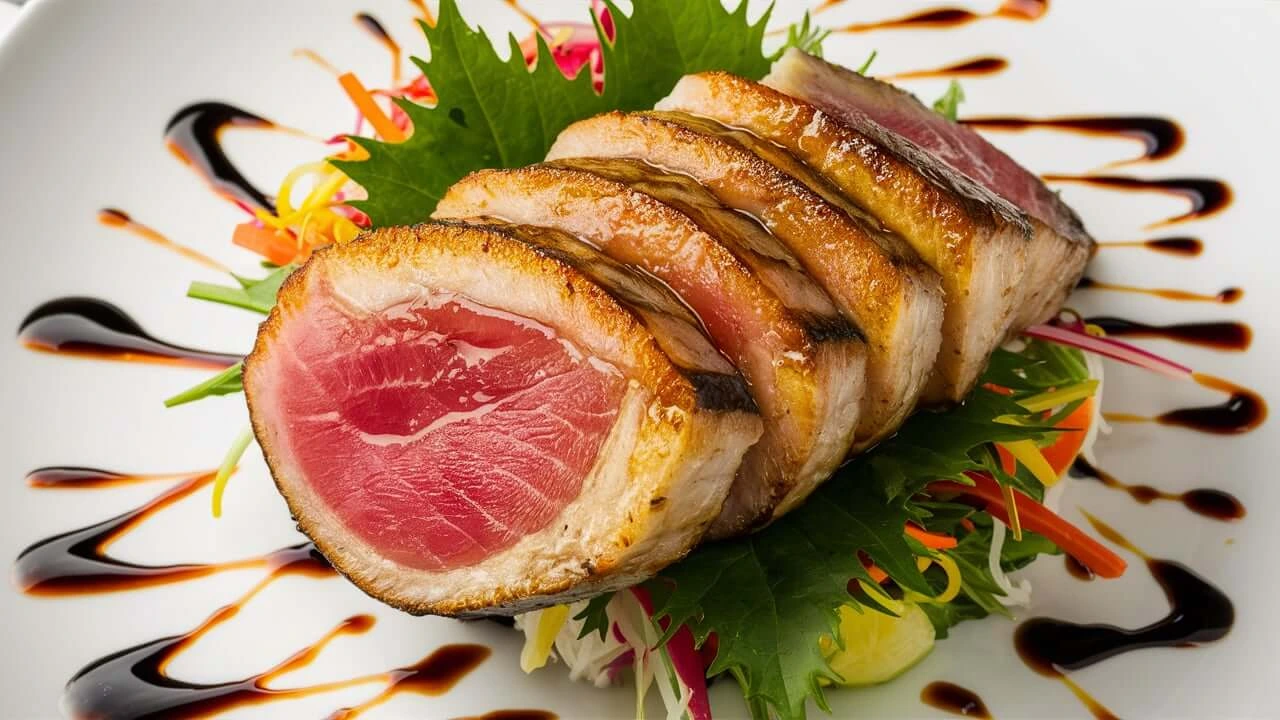Introduction
Discover the simplicity and sophistication of a perfectly seared ahi tuna recipe. With its golden crust and tender, flavorful center, this dish is a true crowd-pleaser. Whether you’re preparing a quick weeknight meal or a special dinner, seared ahi tuna brings restaurant-quality flavor to your table in just minutes. In this guide, you’ll learn how to create a delicious and visually stunning dish with simple steps and fresh ingredients.
What is Ahi Tuna?
1. Types of Tuna Used in Ahi Tuna Recipes
When crafting an exceptional ahi tuna recipe, the choice of tuna is key to texture and flavor. Ahi tuna, typically yellowfin or bigeye, is prized for its quality and versatility, especially in searing recipes.
- Sushi-Grade Yellowfin Tuna: Known for its mild flavor and firm texture, yellowfin tuna is often the go-to choice for dishes like sashimi, poke, and seared tuna steaks. Sushi-grade yellowfin tuna is specially selected and frozen at extremely low temperatures to eliminate parasites, making it ideal for raw or lightly seared preparations.
- Bigeye Tuna: Bigeye tuna is slightly fattier than yellowfin, offering a richer flavor and a smoother texture. This makes it an excellent choice for searing or preparing ahi tuna steaks where the fish’s natural taste needs to shine through. Bigeye is typically more expensive but prized in high-end seafood recipes.
- Characteristics of Fresh Tuna Steaks: Fresh tuna steaks are firm, moist, and free from any off-putting fishy smells. The flesh should have a vibrant pink to deep red color, indicating its freshness. When selecting tuna for recipes like pan-seared ahi tuna, it’s essential to choose steaks that have a clean cut and are thick enough to sear properly without overcooking the inside. Look for a slight sheen on the surface, which is a sign of freshness.
2. Why Choose Ahi Tuna for Searing
Ahi tuna is known for its exceptional texture and versatility, making it a top choice for searing. Here’s why this particular fish stands out in high-heat cooking methods:
- High-Quality Texture and Flavor: The unique texture of ahi tuna—firm yet tender—makes it ideal for quick searing. When seared at high heat, the outer layer of the tuna develops a crispy crust, while the inside remains rare to medium-rare, creating a perfect balance of flavors and textures. The rich, clean flavor of ahi tuna doesn’t overpower the other ingredients, allowing for more subtle flavor profiles from marinades and seasonings.
- Versatility in Different Cuisines: Ahi tuna works wonderfully in a variety of culinary styles, particularly Asian-inspired dishes. Its mild flavor pairs well with bold, flavorful ingredients like soy sauce, sesame oil, and ginger. Whether you’re preparing a quick tuna dinner, a healthy appetizer, or a fusion-style dish, ahi tuna adapts effortlessly to different cooking techniques and seasoning profiles. From Japanese cuisine, like sushi or poke bowls, to more contemporary fusion meals, ahi tuna is a favorite in global kitchens.
3. Where to Buy Fresh Ahi Tuna for Your Recipe
When it comes to purchasing fresh ahi tuna for your recipe, sourcing high-quality cuts is key to making the perfect dish. Here’s how to ensure you’re getting the best fish available:
- Tips on Selecting the Best Cuts: Always opt for tuna steaks that are fresh, bright in color, and firm to the touch. If you’re buying from a local fishmonger or grocery store, ask them to cut the tuna steak in front of you to ensure its freshness. Look for tuna steaks that are at least 1 inch thick, as thinner cuts can dry out during cooking. If you’re planning to serve the tuna rare or medium-rare, be sure to select sushi-grade tuna, which has been frozen to the appropriate temperature to ensure safety.
- Suggested Local Markets or Online Options: If you’re shopping locally, check out your nearest seafood market or grocery store that specializes in fresh fish. Many large supermarkets with a seafood counter will have high-quality ahi tuna, particularly in coastal areas. For online purchases, reputable seafood suppliers like Vital Choice or FishEx offer fresh, sushi-grade tuna delivered to your doorstep. Many of these suppliers also offer sustainable options, ensuring the tuna is sourced responsibly.
Ingredients You’ll Need for a Perfect Seared Ahi Tuna Recipe
1. Essential Ingredients for Ahi Tuna Recipe Success
To create a truly memorable ahi tuna recipe, using the right combination of ingredients is essential. Here are the key components that will elevate your dish:
- Tuna Steaks: Fresh, high-quality tuna steaks are the heart of any ahi tuna recipe. As mentioned earlier, sushi-grade yellowfin or bigeye tuna is ideal for searing due to its firm texture and rich flavor. Sushi-grade tuna is handled and frozen in a way that ensures the fish is safe to consume raw or lightly cooked, making it perfect for recipes like seared ahi tuna steaks or poke bowls.
- Sesame Oil: A fragrant oil with a deep, nutty flavor, sesame oil is a key ingredient in many ahi tuna recipes, particularly those with an Asian-inspired twist. It enhances the tuna’s natural flavors and adds a hint of richness. If you want a more intense sesame flavor, toasted sesame oil is a great option.
- Soy Sauce: Soy sauce brings a savory umami flavor to the dish, balancing the richness of the tuna. It’s a critical ingredient in marinades and dipping sauces. Opting for a high-quality soy sauce can elevate the taste of the dish. For a richer depth of flavor, consider using dark soy sauce.
- Other Key Ingredients: Besides the core ingredients mentioned, your ahi tuna recipe will also require a few supporting ingredients, such as lime juice, which adds freshness and brightness, and black pepper and sea salt to enhance the flavor profile. Together, these ingredients help develop the perfect seared ahi tuna experience with a delicate balance of flavors.
2. Optional Ingredients for Flavorful Variations
While the essential ingredients provide a solid base for your ahi tuna recipe, adding optional ingredients can take the dish to new heights. These ingredients can introduce different flavor profiles and enhance the dish’s complexity.
- Ginger: Fresh ginger adds a zesty, aromatic kick to your ahi tuna. Grating or mincing it gives the dish heat and fragrance. It’s popular in Asian-inspired marinades and sauces, enhancing the flavor.
- Garlic: Garlic brings richness and depth to the dish. Its savory flavor adds complexity. You can finely chop or grate it for marinades or sprinkle it over the tuna. Roasting or sautéing garlic enhances its sweetness and mellowness, balancing the tuna’s richness.
- Chili Flakes: Chili flakes spice up dishes with mild to moderate heat. Add them to marinades or the tuna directly. For a stronger kick, try fresh chili peppers, thinly sliced.
- Alternative Oils or Gluten-Free Soy Sauce: Use oils like avocado or olive oil for searing, though they alter the flavor slightly. For a gluten-free diet, substitute regular soy sauce with gluten-free soy sauce or tamari.
3. Substitutions and Tips for Dietary Preferences
Ahi tuna is naturally low in fat and high in protein, making it a healthy choice for many diets. However, there are a few substitutions and tips you can follow to cater to specific dietary preferences:
- Gluten-Free Options: If you’re following a gluten-free diet, ensure that the soy sauce you use is certified gluten-free, as traditional soy sauce contains wheat. Tamari, a gluten-free version of soy sauce, is a great alternative and is widely available. Additionally, check the sesame oil and other ingredients to ensure there are no hidden gluten-containing additives.
- Low-Sodium Options: For those watching their sodium intake, a low-sodium soy sauce can be substituted without sacrificing too much flavor. Many low-sodium versions of soy sauce still offer a savory umami taste while reducing the salt content. You can also adjust the amount of soy sauce used in the recipe to control the sodium level to your liking.
- Dairy-Free Options: Since ahi tuna is already a dairy-free dish, no substitutions are necessary. However, if you’re making a creamy dipping sauce or marinade, you can easily use non-dairy alternatives like coconut milk or almond milk.
- Low-Carb or Keto Options: For a low-carb or keto version of the recipe, ensure that you’re using sugar-free ingredients in your marinade, such as a sugar-free soy sauce or alternative sweeteners like stevia or erythritol. The fresh tuna steaks, sesame oil, and spices used in the recipe naturally fit into low-carb or keto diets.
- Vegetarian or Vegan Alternatives: If you’re making this recipe for non-meat eaters, consider using marinated tofu or tempeh as a substitute for the tuna. Both options absorb marinades well and have a similar texture to fish when prepared correctly. For a similar flavor profile, you can also explore plant-based fish alternatives that mimic the taste and texture of ahi tuna.

Step-by-Step Guide to Making a Seared Ahi Tuna Recipe
1. Preparing Your Ahi Tuna Steaks
The first step in preparing your ahi tuna steaks is ensuring they are properly thawed and marinated to bring out the best flavor and texture.
- Thawing the Tuna: If you’ve purchased frozen tuna steaks, it’s important to thaw them correctly to preserve their texture. Thaw the steaks in the refrigerator overnight to allow them to defrost slowly and evenly. If you’re in a hurry, you can place the steaks in a sealed plastic bag and submerge them in cold water for about an hour. Avoid thawing tuna in the microwave, as it can alter the texture and cause it to become mushy.
- Marinating the Tuna: Marinating ahi tuna enhances its flavor, helping it absorb the delicious seasonings before cooking. A simple marinade using soy sauce, sesame oil, lime juice, and a touch of garlic or ginger works perfectly. You can marinate the tuna for as little as 15-30 minutes for a light infusion of flavor, or up to an hour for a more intense flavor. For best results, use a shallow dish to ensure the marinade evenly coats the fish. Avoid marinating the tuna for too long (over an hour), as the acidity from the marinade can start to break down the texture.
2. How to Achieve the Perfect Sear in an Ahi Tuna Recipe
Searing tuna steaks properly is the key to achieving a perfectly cooked dish with a crisp, golden crust while maintaining the delicate, tender texture inside.
- Tips for High-Heat Cooking: The secret to getting a perfect sear on your ahi tuna is using high heat. Preheat your pan until it’s hot before placing the tuna steaks in it. This ensures that the surface of the tuna will sear quickly, locking in the juices and creating a flavorful crust. You’ll want to hear a satisfying sizzle when the tuna touches the pan—this means the temperature is right. Keep in mind that because tuna is a delicate fish, you don’t want to overcrowd the pan; cook one or two steaks at a time to avoid reducing the pan’s temperature.
- Using a Cast-Iron Skillet for Even Searing: A cast-iron skillet is the ideal tool for searing ahi tuna. Cast-iron skillets retain and evenly distribute heat, ensuring a consistent sear across the surface of the fish. Heat your cast-iron skillet on medium-high to high heat and add a small amount of oil (sesame or avocado oil works well) to coat the bottom of the pan. Once the oil shimmers, gently place the tuna steaks in the skillet. Avoid moving the steaks around in the pan to ensure they develop a beautiful, crispy sear on each side.
3. Cooking Times for Different Doneness Levels
The cooking time for ahi tuna depends on how you like your fish cooked. Because tuna steaks are often served rare to medium-rare, it’s important to monitor the cooking time closely to achieve the perfect doneness.
- Rare: For rare ahi tuna, sear the steaks for about 1-2 minutes on each side. The outside should develop a crispy, golden crust while the inside remains bright red and cool. Ahi tuna is typically served rare in sushi or seared preparations, offering a soft, melt-in-your-mouth texture.
- Medium-Rare: For medium-rare tuna, sear the steaks for about 2-3 minutes on each side. The outside will still have a beautiful sear, while the inside will be slightly pink and warm. This is the most popular doneness for seared ahi tuna, as it maintains the tenderness of the fish without overcooking it.
- Well-Done: If you prefer your tuna more well-cooked, sear it for 4-5 minutes on each side, ensuring the inside is fully cooked. However, keep in mind that overcooking tuna can result in a drier texture, so it’s best to only cook it well-done if you prefer that level of doneness.
- Using a Kitchen Thermometer: To avoid overcooking or undercooking your tuna steaks, consider using a kitchen thermometer. For rare tuna, the internal temperature should be around 120°F (49°C), medium-rare is 130°F (54°C), and well-done is around 145°F (63°C). A thermometer ensures precise cooking for perfect results every time.
4. Resting and Serving Your Seared Ahi Tuna
Once your ahi tuna steaks are perfectly seared, it’s important to let them rest before serving. Resting allows the juices to redistribute throughout the fish, ensuring each bite is moist and flavorful.
- Why Resting Enhances Flavor: After searing, remove the tuna steaks from the skillet and place them on a cutting board or plate. Let them rest for 5 minutes before slicing. This resting time gives the fish a chance to finish cooking through from the residual heat, while the flavors from the marinade settle and intensify. It also allows the juices that have been sealed in during the searing process to redistribute within the fish, ensuring a tender and juicy steak.
- Serving Suggestions: Once rested, you can slice the tuna against the grain into thick strips or serve it whole, depending on your preference. Ahi tuna pairs beautifully with fresh salads, rice, or Asian-inspired side dishes like sautéed vegetables or seaweed salad. For a more elegant presentation, drizzle a soy-based sauce or wasabi mayo over the tuna, or garnish with sesame seeds, lime wedges, or chopped herbs.

Best Sides and Sauces to Serve with a Seared Ahi Tuna Recipe
1. Asian-Inspired Side Dishes for Ahi Tuna
Ahi tuna pairs wonderfully with side dishes that complement its rich, savory flavors. For a truly authentic and balanced meal, consider these Asian-inspired options that bring freshness, texture, and flavor:
- Rice: A bowl of warm, fluffy rice is an excellent base for seared ahi tuna. You can opt for traditional steamed white rice, which is light and neutral, allowing the tuna to shine. For a more flavorful twist, try sushi rice, which is seasoned with rice vinegar, sugar, and salt for a touch of tang. If you’re seeking a healthier option, brown rice offers a nuttier flavor and added fiber, providing a heartier side.
- Noodles: Asian-style noodles are another great accompaniment to ahi tuna. Cold soba noodles, made from buckwheat flour, pair beautifully with seared tuna, offering a subtle nutty flavor and a slight chewiness. Alternatively, egg noodles or rice noodles can be served either hot or cold, dressed with a light soy-sesame dressing for extra flavor. These noodles create a balanced contrast with the tender tuna and offer a satisfying texture.
- Seaweed Salad: A refreshing seaweed salad adds a burst of umami and a crunchy texture that contrasts nicely with the tender tuna. Made from various types of seaweed like wakame, kombu, or nori, the salad is typically seasoned with sesame oil, soy sauce, and rice vinegar, providing a light, tangy flavor. The natural saltiness of the seaweed enhances the flavor of the tuna, making it a perfect side dish.
2. Classic Sauces for Ahi Tuna Recipes
To elevate your ahi tuna recipe, a flavorful sauce is essential. Here are a few classic options that pair beautifully with tuna’s delicate flavor:
- Soy-Ginger Glaze: A sweet and savory soy-ginger glaze is a classic pairing with ahi tuna. The soy sauce provides a salty umami flavor, while the fresh ginger adds warmth and a subtle heat. Brown sugar or honey can be used to sweeten the glaze, creating a balanced, glossy sauce that can be drizzled over the tuna for added depth. This glaze works especially well if you’re preparing your tuna in a stir-fry or grilling it.
- Wasabi Mayo: Wasabi mayo combines the creaminess of mayonnaise with the spicy kick of wasabi, creating a delicious contrast to the rich tuna. This sauce can be used as a topping for ahi tuna or served on the side for dipping. Its creamy texture and zesty heat enhance the tuna without overpowering it, making it a popular choice for fusion-style dishes like ahi tuna sliders or poke bowls.
- Ponzu Sauce: Ponzu sauce is a citrus-based Japanese sauce that combines soy sauce, rice vinegar, and citrus juice (typically yuzu or lemon). It provides a light, tangy, and slightly sweet flavor that perfectly complements the freshness of ahi tuna. Ponzu sauce can be used as a marinade before cooking or served as a dipping sauce on the side, enhancing the tuna’s natural flavors with its zesty and slightly salty notes.
3. Healthy Vegetable Pairings
Ahi tuna pairs wonderfully with a variety of fresh, healthy vegetables, which bring crunch, color, and nutritional value to the dish. Here are some vegetable options to consider for your meal:
- Steamed Broccoli: Steamed broccoli is a simple yet nutritious vegetable that complements ahi tuna beautifully. The slight bitterness of broccoli balances the richness of the tuna, while its crisp texture contrasts with the tenderness of the fish. To enhance the flavor, toss the broccoli with a splash of soy sauce or sesame oil before serving.
- Grilled Asparagus: Asparagus, when grilled, develops a smoky, slightly charred flavor that complements the clean taste of tuna. The firm texture of asparagus pairs well with the soft, melt-in-your-mouth texture of ahi tuna. Simply drizzle the asparagus with olive oil, season with salt and pepper, and grill until tender. You can also finish it with a squeeze of lemon juice for added freshness.
- Avocado Salad: A refreshing avocado salad made with ripe avocado, cucumber, and a light sesame dressing makes for a vibrant side dish to serve alongside your ahi tuna. The creaminess of avocado adds richness to the meal, while the crisp cucumber offers a refreshing contrast. A sprinkle of sesame seeds on top brings an extra layer of flavor and crunch.
4. Garnishing Ideas for an Elegant Presentation
Presentation is key when serving seared ahi tuna, and garnishing can transform the dish into a visually stunning masterpiece. Here are some elegant garnishing ideas to elevate your tuna recipe:
- Sesame Seeds: Toasted sesame seeds add crunch and a nutty flavor to ahi tuna. Sprinkle them on top or coat the tuna before searing. A mix of white and black sesame seeds enhances taste and adds visual appeal.
- Lime Wedges: A squeeze of lime boosts the flavor of ahi tuna with a zesty citrus burst. Serve lime wedges on the side or drizzle lime juice over the tuna to bring out its natural sweetness.
- Microgreens: Microgreens, such as cilantro, radish, or basil, can be used to add a pop of color and an extra layer of freshness to the dish. These delicate greens not only look beautiful but also provide subtle flavors that complement the richness of the tuna. Arrange them artfully on top of the tuna or scatter them around the plate for an elegant presentation.
- Edible Flowers: For a truly upscale presentation, consider garnishing your ahi tuna with edible flowers. Nasturtiums, pansies, or violets can add a splash of color and a touch of sophistication to the plate, making the dish look even more visually appealing.

Tips and Tricks for Perfecting Your Seared Ahi Tuna Recipe
1. How to Avoid Overcooking Ahi Tuna
Overcooking ahi tuna can turn this delicate, tender fish into a dry and chewy disappointment. The key to perfectly cooked ahi tuna lies in the balance between searing the outside while preserving the moist, rare interior. Here’s how to avoid overcooking:
- The Importance of Quick Searing: Ahi tuna needs a quick sear, typically 1-3 minutes per side, based on your doneness preference. High heat creates a crispy, golden exterior while locking in moisture, keeping the inside rare or medium-rare. To prevent overcooking, preheat the pan before adding the tuna. The sear should be swift, so don’t leave the tuna on the heat too long.
- Monitoring Doneness: A quick tip to avoid overcooking is to keep an eye on the color of the tuna as it cooks. For rare tuna, the center should remain bright red and cool, while the outside is seared. For medium-rare, the center should have a pinkish hue. Use a kitchen thermometer to check the internal temperature if you’re unsure; 120°F (49°C) is ideal for rare, while 130°F (54°C) is perfect for medium-rare.
2. Making Your Recipe Gluten-Free or Low-Sodium
If you or your guests have dietary restrictions, such as a gluten sensitivity or a need for a low-sodium diet, making a few simple adjustments to your ahi tuna recipe can accommodate these preferences:
- Adjustments to Soy Sauce: Traditional soy sauce contains gluten and is high in sodium. To make your recipe gluten-free, use tamari. For lower sodium, choose reduced-sodium soy sauce or tamari. Both options maintain the rich umami flavor without overwhelming your dish with salt.
- Marinade Adjustments: For a low-sodium marinade, reduce or replace soy sauce with coconut aminos. Add citrus (lime, lemon, or orange), garlic, ginger, or honey to balance the flavors. Experiment with herbs and spices like chili flakes, cilantro, or balsamic vinegar to enhance taste without increasing sodium.
3. Storage and Reheating Tips for Ahi Tuna Recipes
If you have leftover ahi tuna, it’s important to store and reheat it properly to maintain its flavor and texture. Here are some essential tips for handling leftovers:
- Proper Storage for Leftovers: To keep your ahi tuna fresh, store it in an airtight container in the refrigerator. Refrigerate it within 2 hours to avoid bacterial growth. If the tuna is still warm, allow it to cool to room temperature before storing. Consume within 1-2 days for the best flavor and texture.
- Reheating Ahi Tuna: Ahi tuna is best enjoyed freshly seared. If reheating, do it gently to preserve its delicate texture. Heat in a skillet over low heat, or microwave on low for short intervals. Alternatively, wrap the tuna in foil and warm it in the oven at 275°F (135°C) for 10-15 minutes. Avoid overcooking, as it can dry out.
4. Experimenting with Flavors in Ahi Tuna Recipes
Ahi tuna is incredibly versatile and lends itself well to various flavor profiles. Here are some ways to experiment with new and exciting flavors in your ahi tuna recipes:
- Adding Unique Spices: Give your ahi tuna a bold twist by experimenting with different spices. For spiciness, add chili powder, cayenne pepper, or red pepper flakes to your marinade. For sweetness, try cinnamon or smoked paprika. You can also use five-spice powder, which combines star anise, cloves, cinnamon, Sichuan peppercorns, and fennel seeds for a warm, aromatic flavor.
- Creative Marinades: Traditional soy sauce-based marinades are popular, but don’t be afraid to mix it up. Use citrus juices like lime or orange, honey, or mustard for a sweet-tangy marinade. For an Asian twist, add miso paste or gochujang for a rich umami flavor. Fruit-based marinades like pineapple or mango add a tropical, sweet-savory profile.
- Fusion Flavors: If you enjoy exploring cuisines, try international flavors with your ahi tuna. A miso-lime glaze or wasabi-lemon butter sauce blends Japanese and Western tastes. For a Latin twist, serve with cilantro-lime marinade and avocado salsa. Ahi tuna is a blank canvas for bold, unique combinations.
Conclusion
Ahi tuna recipes offer the perfect blend of simplicity and gourmet appeal. With a few essential ingredients, a quick searing technique, and the right accompaniments, you can create a stunning meal. It’s healthy and bursting with flavor. Whether you’re preparing a light dinner or a sophisticated appetizer, ahi tuna allows for endless culinary creativity. The ease of preparation and impressive results make it a go-to choice for casual meals and special occasions.
We’d love to see your culinary creations! Share your beautifully seared ahi tuna dishes on social media. Don’t forget to tag us so we can celebrate your cooking skills.
If you enjoyed this recipe, why not try some of our other exciting dishes? Try our sushi-inspired appetizers for a fresh, creative twist on your next meal. Explore new ways to elevate your cooking with easy-to-make, delicious recipes everyone will love.


2 thoughts on “Ahi Tuna Recipe: Seared, Easy Preparation, and Delicious Flavor”